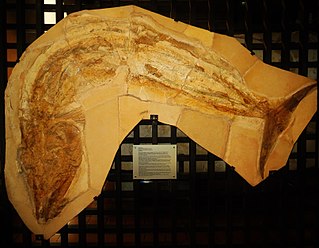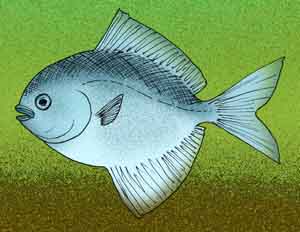Elopopsis is an extinct genus of prehistoric bony fish that lived from the Cenomanian to Campanian.
Salminops is an extinct genus of prehistoric bony fish that lived during the Cenomanian known from USA and Portugal.
Flindersichthys is an extinct genus of prehistoric bony fish that lived during the Albian stage of the Early Cretaceous epoch.
Enischorhynchus is an extinct genus of prehistoric bony fish that lived during the Turonian of southern Texas.
Oligopleurus is an extinct genus of prehistoric bony fish that lived during the Kimmeridgian stage of the Late Jurassic epoch.
Aphnelepis is an extinct genus of prehistoric bony fish that lived during the Middle Jurassic epoch.

Watsonulus is an extinct genus of prehistoric ray-finned fish that lived during the Early Triassic epoch in what is now Madagascar. It may have also existed in what is now Himachal Pradesh, India, during the Induan age. The type species, described by Jean Piveteau, is Watsonia eugnathoides. Because "Watsonia" was preoccupied, the new genus name Watsonulus was later erected. The genus is named after David Meredith Seares Watson.
Paramesolepis is an extinct genus of prehistoric bony fish that lived during the Tournaisian stage of the Mississippian epoch.

Strongylosteus is an extinct genus of prehistoric ray-finned fish that lived during the early Toarcian age of the Early Jurassic epoch. Its type species is Strongylosteus hindenburgi (monotypy). It is related to modern sturgeon and paddlefish (Acipenseroidei), but with a different kind of mouth than common species, made for hunting prey in open waters, with a strong lower jaw, similar to modern beluga sturgeon.

Asthenocormus is an extinct genus of large marine pachycormiform ray-finned fish. It contains a single species, A. titanius. A member of the edentulous suspension feeding clade within the Pachycormiformes, fossils have been found in the Upper Jurassic plattenkalks of Bavaria, Germany.
Naxilepis is an extinct genus of prehistoric bony fish.

Notelops is an extinct genus of prehistoric ray-finned fish.
Orvikuina is an extinct genus of prehistoric bony fish.
Osorioichthys is an extinct genus of prehistoric bony fish.
Pholidoctenus is an extinct genus of prehistoric ray-finned fish.
Pholidolepis is an extinct genus of prehistoric ray-finned fish.
Pholidophoroides is an extinct genus of prehistoric ray-finned fish.
Pholidophoropsis is an extinct genus of prehistoric ray-finned fish.
Parapholidophorus is an extinct genus of prehistoric bony fish.

Pasaichthys pleuronectiformis is an extinct, prehistoric moonyfish that lived during the Lutetian epoch of Monte Bolca, Italy. The average length of its fossils is about 6 centimeters. In life, it would probably resemble its living relatives of the genus Monodactylus.





